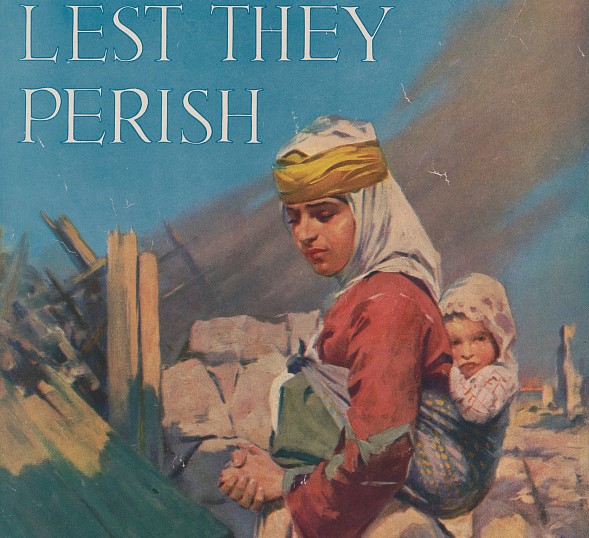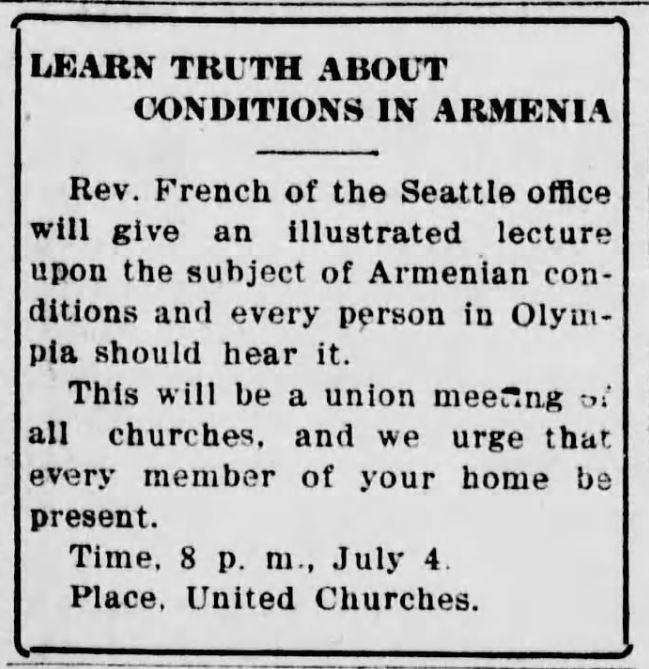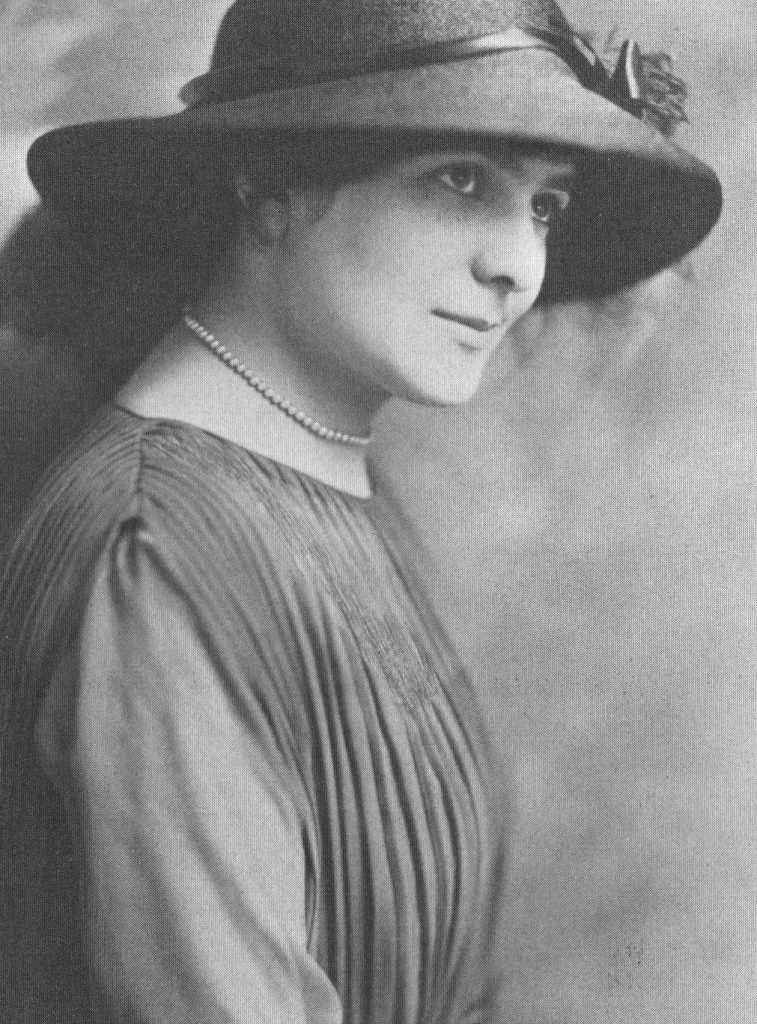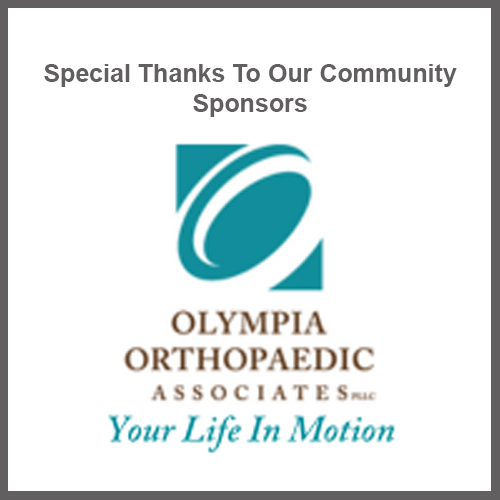The Armenian Genocide, 1915-1916, was one of the worst humanitarian crises of the 20th century. International efforts to help survivors were extensive. Led by the Near East Relief, now the Near East Foundation, people around the world and here in Thurston County rallied to provide aid.
Thurston County Council Reacts to Medz Yeghern, the Armenian Genocide
Armenians are an ethnic group in Western Asia, then ruled by the Ottoman Empire. The Ottoman Empire sided with Germany during World War I. Seeing the Christian Armenians as the enemy, they were targeted for destruction. In total over a million Armenians were killed or died of starvation and disease. Greeks and Assyrians were also victims of genocide.
The American Committee for Syrian and Armenian Relief was founded in 1915. But this was not the first time that people in Thurston County had helped Armenians. In the mid-1890s, Olympia churches raised money to aid survivors of the Hamidian massacres.
During War World I, the Committee’s requests for donations were met by the Thurston County Council of Defense’s treasury. The Council collected money and distributed it to wartime charities as they saw fit. According the Council of Defense’s final report, it gave $3,698 to the Near East Relief during 1917-1919.

Post-War Fundraising in Thurston County
The World War I armistice did not bring an end to conflict in the Near East. The Committee changed its name to Near East Relief in 1919. The group now directly raised money in Thurston County. Local churches and clubs took the lead, holding annual subscription drives as special events like a 1920 “Tag Day” sale where people bought paper tags for a small donation to show support.
The two-week 1924 drive was a typical one. J.J. Handsaker, regional director of the Near East Relief, Rev. William Worthington and Rev. Marcus B. Paronnagian spoke at churches. Paronnagian, an Armenian from Salem, also spoke at a Kiwanis banquet. Besides the drive, people collected men’s, women’s, and children’s clothing, bed linens, blankets and shoes. Donations were dropped off at schools, churches and the YMCA.

Churches held annual Golden Rule Sundays to encourage donations. Other groups, like the Roosevelt PTA, organized fundraising teas. St. John’s Episcopal Church held an elaborate Golden Rule Tea at the church’s Parish House in November 1924. Decorating the hall with rugs, flags and the Armenian national colors, guests enjoyed a musical program including singing by 40 Sunday school children dressed up as Armenians.
Child sponsorships were also popular. In November 1920, Olympia High School students subscribed $2,064 after a talk by Dr. Lincoln Writ. Groups such as the Ladies Circles of the United Churches and the Sunset Club also sponsored children during the decade.
Near East Speakers Visited Thurston County
To raise awareness about the dire situation in the Near East, many speakers visited the County during the 1920s. Margaret Reid even brought a film, “Seeing is Believing, Or Uncle America Sees It Through,” to a union meeting of churches at the Community House. In November 1927 Mabel Dodds of Tacoma exhibited a collection of embroidery at the Hotel Olympian made by refugees supported by Near East Relief.
Most of the speakers were Near East Relief workers on tour for the organization after serving overseas. One former volunteer included Clara Van Etten, an Olympia woman who had volunteered at an orphanage in Smyrna. Van Etten even chaired a 1920 Near East fundraising drive in the county. She accompanied two Armenian boys to the United States and kept in touch with them. In December 1925 Mihran Andonian, a University of Washington student, visited her for the holidays. The other boy, Armen Ghoughassian was a senior at Broadway High School in Seattle at the time. Andonian later owned Pande Cameron, a carpet and rug business in Seattle and recorded his memories of the genocide for the University of Southern California Shoah Foundation before his death. His family continues the business today.

Armenian Americans
Very few Armenians were living in the region at the time. It made the papers in May 1923 when the Northern Pacific Railroad’s “extra gang no.1,” putting in new railroad ties in and around Olympia, were all Armenians.
However, several Armenian speakers visited Olympia to fundraise for Near East Relief. This included Mooshek Vorperian, a teenager who lost most of his family in the genocide before coming to the United States. He spoke at the Methodist Church in June 1917.
In January 1921 Florence Krikorian, wife of Seattle rug merchant Mesrop Krikorianm gave a presentation at the Christian Church. A Hamidian massacres survivor, she had moved to America as a child.
Armenouhie Tashjian Lamson, wife of prominent Seattle physician Otis Lamson, spoke on “Armenia and Macedonia and the Turkish Atrocities” at First Presbyterian Church in April 1918, sponsored by the National League for Women’s Service. A medical illustrator and author of popular books on fetal development and childbirth, she returned in October 1920 to speak at United Churches with Dr. H.P. Packard. Packard had served as a medical missionary in Iran for 19 years and had recently returned from the war-torn Urmia district.
Near East Foundation Legacy
While Thurston County’s donations to the Near East tapered off during the Great Depression, the Near East Foundation, as it was renamed in 1930, continues its good work in the region today, including Armenia.




















































